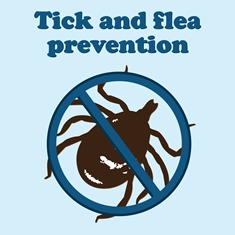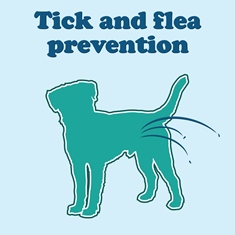Is your dog tired or achy after a walk? Is your cat eating less than usual? These seemingly minor changes may indicate your pet has a tick-related disease, and you may not even realize it.
Ticks are tricky. Even when you check your pet for ticks they can be tough to find because they’re small and hide well in dark fur. But it’s crucial to find ticks and remove them quickly. Why?
Some ticks carry bacteria referred to as a spirochete that cause disease such as Lyme disease, but there are many others. And it just takes one undetected tick bite for your pet to become infected. Not all pets show classical symptoms in 4-8 weeks. Some pets might not show any symptoms for months to years. If undiagnosed and untreated your pet can become very sick and eventually develop kidney damage. At times, these diseases can be fatal.
Starting in early spring, check for ticks on your dog’s body immediately after every outdoor walk. Ticks can hide between your pet’s toes, the underside of the toes, in the ear flaps and around the tail base. Use a magnifying glass to determine whether or not you are looking at a tick – a bump with “legs” is most likely a tick. The goal is to remove ticks as soon as possible within the first 24 hours before disease-causing bacteria is transmitted by the tick bite to your pet.
What if you do find a tick on your pet? Make sure you wear gloves and ideally use a tick-removing tool. It’s a must that the tick be removed correctly to avoid inadvertently spreading infection by crushing the tick in bare hands or mishandling.
Follow these tips suggested by the AVMA:
- Remove ticks by carefully using tweezers to firmly grip the tick as close to the pet’s skin as possible and gently and steadily pulling the tick free without twisting it or crushing the tick during removal.
- Do not attempt to smother the tick with alcohol or petroleum jelly, or apply a hot match to it. This may cause the tick to regurgitate saliva into the wound and increase the risk of disease if the tick is infected.
- Crushing, twisting or jerking the tick out of the skin while its head is still buried could result in leaving the tick’s mouth parts in your pet’s skin; this can cause a reaction and may become infected.
- After removing the tick, crush it in a napkin or tissue to avoid contact with tick fluids that can carry disease. You can safely flush the tick down the toilet.
It’s a good idea to disinfect your dog’s skin with soapy water or diluted povidone iodine (Betadine) after removing the tick. Monitor the area for the next few days, and if you notice any irritation or inflammation of the skin, you should contact your veterinarian immediately.
Your veterinarian may suggest having your dog tested for tick-borne diseases about three to four weeks after removing a tick. If you choose not to have the blood test, then it’s important to watch your dog closely for several months for any signs of loss of appetite, lethargy, changes in gait, fever and intermittent limping. These are all symptoms of potential tick-borne diseases, but again, early detection is critical. By the time you notice these symptoms, disease has already set in, however, so please consider testing at your veterinarian’s recommendation.
 Checking your dog externally for ticks and having his blood checked annually by your veterinarian for tick diseases like Lyme, Anaplasma, and Ehrlichia is a good way to help your pet stay healthy. When detected and treated early, tick-related diseases can be cured.
Checking your dog externally for ticks and having his blood checked annually by your veterinarian for tick diseases like Lyme, Anaplasma, and Ehrlichia is a good way to help your pet stay healthy. When detected and treated early, tick-related diseases can be cured.
The best way to prevent dogs from devastating tick diseases in dogs is to use a safe monthly preventative all year long. Ask your vet what would be best for your pet. Whatever you do, don’t pay to spray your yards against flea and ticks. It is not good for your pets.
If you suspect a tick-borne disease, call your veterinarian to set up a thorough exam. Your vet will also check for hidden ticks along the way. We’ll also talk about how to keep your pet tick-free and determine if a simple tick-borne disease-screening test is needed.
Recommended Reading:
NexGard – an FDA approved chewable to combat fleas and ticks on your dog
Ensuring healthy pets ensures healthy families
Dr. Joe Martins, DVM, Belle Mead Animal Hospital





